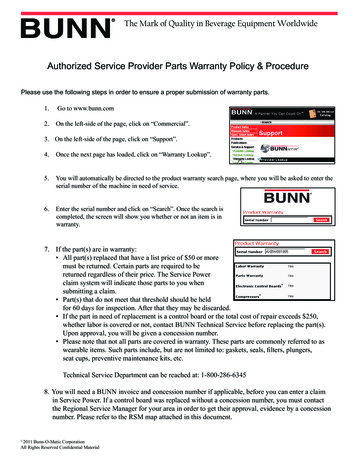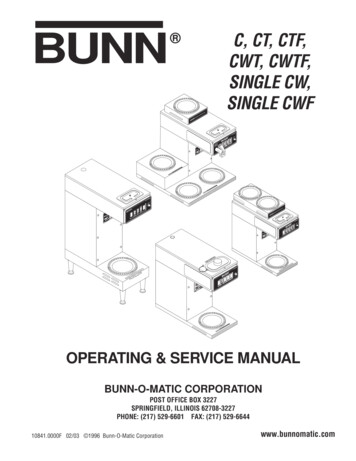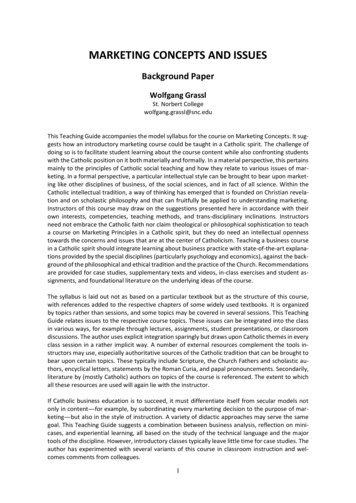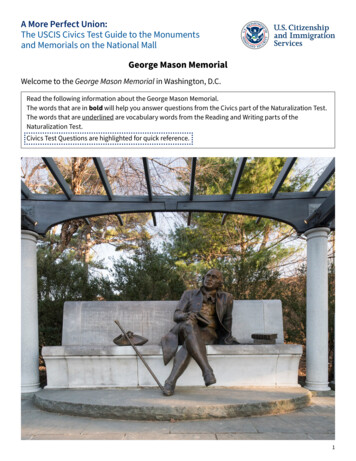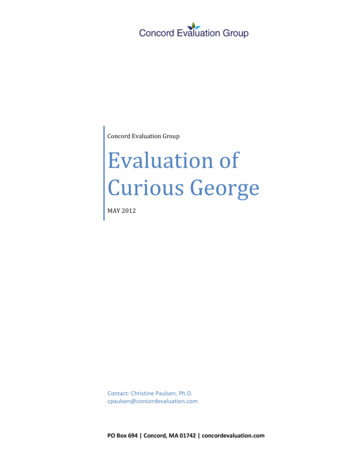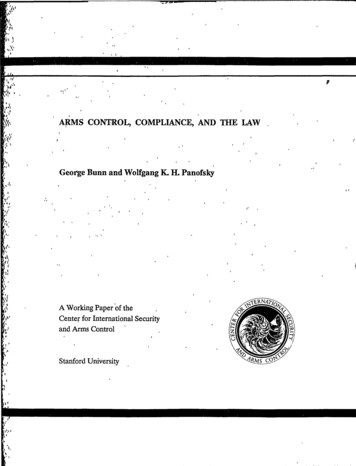
Transcription
I*FARMS CONTROL, COMPLIANCE, AND THE LAWrGeorge Bunn and Wolfgang K. H. PanofskyA Working Paper of theCenter for International Securityand Arms ControlStanford University
ARMS CONTROL, COMPLIANCE, AND THE LAWGeorge Bunn and Wolfgang K. H. PanofskyA Working Paper of theCenter for International Securityand Arms ControlStanford UniversityMay 1988
Wolfgang K. H. Panofsky. is Professor and Director Emeritus of the Stanford . . Linear Accelerator Center and Chairman of the National Academy of SciencesCommittee on International Security and Arms Control.George Bunn is Professor and D ean Emeritus of the University of WisconsinSchool of Law and former General Compel and’Ambassador of the U.S. ArmsControl and Disarmament Agency. H e is a member-in-residence of the Center forInternational Security and Arms Control.The authors acknowledge the assistance of the John D. and Catherine T.MacArthur Foundation through a grant to George Bunn for research and writingin international security. The opinions expressed are those of the authors and donot represent positions of the Center for International Security and Arms Control,its supporters, or Stanford University.Center for International Security and Arms Control320 Galvez StreetStanford, California 94305-6165(415) 723-9625Copyright 1988 by the Board of Trustees of theLeland Stanford Junior University
ARMS CONTROL, COMPLIANCE, AND THE LAWThe United States and Soviet Union have signed the INF Treaty. Arms controltalks are in various stages. The bilateral START forum and multilateralnegotiations on chemical weapons continue in Geneva. Nuclear test bandiscussions are resuming for consideration of means to tighten verification, asdemanded by the Reagan administration as a condition for ratification of theThreshold Test Ban Treaty and Peaceful Nuclear Explosions Treaty, signed over adecade ago. Many observers hope that stricter limits on nuclear testing will alsoresult. Partially in consequence of the INF Treaty and the demonstratedwillingness of the Soviet Union to accept asymmetric reductions, pressures fordecreasing the dangers and burdens of conventional weapons in Europe will almostcertainly lead to further arms control negotiations toward that end.The expected degree of compliance with agreements or treaties (we use thetwo terms interchangeably) under negotiation must be inferred from the record ofthe past as well as from the expectations that are raised by the willingness ofthe parties to dedicate increased resources to verification, to accept moreintrusive inspections, to exhibit greater openness, and to provide for cooperativeverification measures. Yet such expectations for compliance must be tempered bythe recognition of fundamental factors, which we will discuss.The public discourse dealing both with the record of the past and theexpectation of future compliance has too often been simplistic. Standards areinvoked for compliance with arms control that one would not dream of applyingto compliance with domestic law. Overall compliance with recent arms controlagreements has in fact been good, although there are numerous disputes on1
specific items of conduct. Yet the perception of past compliance has beendistorted by public charges of violation that are either downright mistaken or outof context or that stem from ambiguous treaty language or conduct.In our discussion of the compliance process we invoke a broad standard thatwe believe should apply: An arms control agreement is worthy of support by theUnited States if, with adequate verification, its result improves U.S. nationalsecurity. Under this standard we analyze the compliance process relating to armscontrol, and we examine its similarities and dissimilarities to the domesticstatutory process.In comparing arms control with domestic law, we are making the consciousassumption that a world with unconstrained nuclear arms competition is no moretolerable than a domestic society without law. Arms control agreements attemptto manage the weapons activities among nations so as to increase each nation’ssecurity and decrease the danger of devastating war and the burden of armaments.As a middle course between unilateral disarmament and an unfettered arms race,arms control is a complex and difficult process. But so is domestic law, as amiddle course between individual license and arbitrary state power. Yet in a realsense both arms control and domestic law are essential elements of a durablecivilization. Thus a comparative evaluation should help to clarify the balance ofvalues inherent in arms control. The choice cannot be between perfect compliancewith arms control and no arms control at all. Such a choice is no more feasiblethan one between perfect law enforcement and absence of law.We survey the record of compliance with some past arms control agreementsand come to the conclusion, perhaps surprising to some, that recent arms controlagreements have in fact effectively governed the conduct of the Soviet Union andthe United States. We also conclude that, although arms control violations shouldin no way be condoned, verification and compliance problems are frequentlyexaggerated. In fact, most of the issues that arise stem from dissatisfaction withthe basic strictures of the agreements; allegations of noncompliance thus oftenserve as a cover for such dissatisfaction.2
The Arms Control ProcessThe question of compliance is interwoven with the entire process of arms control.We consider compliance as it relates to the three major phases of the armscontrol process: (1) negotiated drafting of the provisions of a treaty with dueregard to future compliance; (2) designing of verification measures to ascertainthe facts about the degree of compliance with a treaty; and (3) implementation ofan agreement in a manner to maximize compliance.Drafting an AgreementThe drafting of a basic agreement must confront conflicting values that arerelated to future compliance. First, there is the matter of "precision versusbreadth." If the provisions of the treaty are drawn too precisely in terms of thetechnical military situation at the time of drafting, ambiguities and loopholes areapt to develop as that situation changes. If the treaty is drawn too broadly,compliance will face gray areas whose management should have been anticipatedin the treaty.Second, there is the matter of "creative ambiguity." When there are realdifferences in position among the parties during the treaty-drafting process, itmay be expedient, or even unavoidable, to bridge these differences by draftingambiguous terms rather than reconciling the differences. But such ambiguityinvites future problems.An example of deliberate treaty ambiguity concerns encryption and the SALTII Treaty. During negotiations and drafting, both the United States and SovietUnion recognized that interception of telemetry data during missile testing is avaluable asset for verifying the characteristics of missile systems. They alsorecognized that encrypting such data can, at least in part, deny such informationand that other methods, such as encapsulating and then dropping a data containerfor later recovery or minimizing the use of telemetry during the testing process,can inhibit foreign acquisition of test data. Agreement on total prohibition oftelemetry encryption proved impossible (but has become possible for START by theagreement reached in the December 1987 summit between President Reagan andGeneral Secretary Gorbachev). Instead, the two sides adopted a compromise, thattelemetry may not be denied "whenever such denial impedes verification of3
compliance with the provisions of the Treaty" (SALT II, Article XV, SecondCommon Understanding). The Soviets subsequently greatly increased the use ofencryption of telemetry. When the United States challenged this practice, theSoviets offered to open up those channels that the United States deemed essentialto verifying treaty compliance. The United States was unwilling to identify thespecific channels, arguing that such identification would compromise "sources andmethods" of intelligence collection. In this case the United States made adeliberate choice to retain the ambiguous compromise as preferable to either anoutright ban on encryption or no ban at all.Third, there is the matter of compliance itself. The substantive provisions ofa treaty should facilitate compliance. Drafting them may thus require a balanceof values between the most desirable weapons restraints and the optimumverification procedures. For instance, the "double-zero" provisions of the INFagreement offer substantial verification advantages over numerical limits otherthan zero. Because burdensome identification and precise counting of permittedmissiles are not required, the observation of any single intermediate-rangeballistic missile would constitute proof of a clear violation.Fourth, there is the m atter of expectations of change in technology. Forexample, the 1972 ABM Treaty directly anticipates possible future ABM systemsbased on "other physical principles." At the time the treaty was drafted, an ABMsystem consisted of early-warning radars, acquisition and battle-managementradars, interceptor missiles with nuclear warheads and their launchers, and adata-management control system tying all the subsystems together. The draftersrecognized that other technologies might show promise in the future. In fact,several spaceborne ABM systems had been studied but found wanting, and researchon new ABM technologies was in process. Article II of the treaty acknowledgesboth the then-existing and the expected future technologies by defining an ABMsystem as "a system to counter strategic missiles or their elements in flighttrajectory, currently consisting" of radars and interceptors and their launchers.Further, Article V and the annexed Agreed Statement D recognize the possibleimpact of future technologies on the treaty.Article V explicitly forbids development, testing, or deployment of "ABMsystems or components which are sea-based, air-based, space-based, or mobileland-based." This statement is generic, not tied to a specific technology. At thetime of drafting, no systems built or planned fitted into these categories. The4
treaty as amended in 1974 prohibits deployment of ABM systems or componentsexcept for limited placement by each party at a single fixed site on land. Inorder to forestall the deployment of systems and components using "other physicalprinciples" at this site, Agreed Statement D requires U.S.-Soviet discussion in casesuch exotic systems are "created" (meaning, by consensus, "developed and tested")as a result of the permitted research and development activities on fixed, landbased ABM systems.Notwithstanding the treaty text, specifically designed to anticipatetechnological progress, the Reagan administration announced on October 6,1985,its "reinterpretation" of the ABM Treaty, maintaining that testing and developmentinvolving new physical concepts are permitted by the treaty and that onlydeployment is foreclosed. We do not deal with the resulting dispute in thispaper AEven within the traditional interpretation of the ABM Treaty, a considerablegray area surrounds what might reasonably be considered allowed or forbiddenconduct; such treaty terms as "ABM component," "testing in an ABM mode," and"provide a base for" permit some latitude of interpretation.The treaty' corporated a consultative mechanism, the Standing Consultative CommissionVSCC), to deal with such gray areas.The Strategic Defense Initiative Organization (SDIO) has submitted plans fortests that it states comply with the traditional interpretation of the ABM Treaty;in accordance with congressional action, SDI test activities for fiscal year 1988will be so restricted. A paradoxical situation results. Some tests are of thenature of demonstrations; their purpose is to persuade the public that feasibleABM technologies are close at hand. Yet, according to the traditionalinterpretation of the treaty, testing or development of an ABM component basedon other physical principles-a component having the function of one in existenceat the time the treaty was negotiated--would constitute a violation of the treaty.Thus on the one hand the administration claims limited effectiveness of theprojected tests in order to show compliance with the ABM Treaty, whereas on theother hand it claims that these very tests advertise technological readiness. Thisambivalence produces conflicts among official statements and programs and inducesdoubts at home and abroad that particular tests comply with the treaty. Thesituation calls for invoking mechanisms for consultation with the Soviets in orderto reach agreement on the issue of allowed-versus-forbidden conduct. Thus far5
the administration has not been willing to invoke these mechanisms, but theShevardnadze-Shultz discussions at the end of March 1988 indicate that theadministration acknowledges that the issue cannot be separated from a STARTagreement.Such examples show how conflicts of value arise during the drafting oftreaties and how subsequent compliance disputes become unavoidable. Yet inthese examples the provisions containing potential for disputes were consideredpreferable to no terms at all or to terms stating precise but possibly perishableboundaries between allowed and forbidden conduct.Designing Verification MeasuresThe second phase of the arms control process, verification, has received somuch prominence in public discourse that many consider it to be the onlyessential element governing compliance. "Trust and verify," to quote PresidentReagan at the 1987 summit, is hardly a prescription for compliance. The goals ofverification are three: (1) detection of a class of "suspicious events," that is,possible violations; (2) identification of these events to determine whether or notthey are prohibited; and (3) measurement to verify compliance or noncompliancewith a treaty’s quantitative limits.The tools of verification are the collection and analysis of information neededto monitor compliance with arms control provisions. The means to collect suchinformation, which analysts have discussed extensively, include (1) nationaltechnical means (NTM), such as satellite surveillance, radar surveillance fromlocations outside the boundaries of the country monitored, air sampling,teleseismic geophysical observations, and intercept of communications and othersignals; (2) cooperative means of verification, such as deliberate openness ofcertain features of military systems, specific channeling of military productsthrough agreed-upon check points, and noninterference with means of verification;(3) technical devices emplaced on the territories of parties to the agreement;(4) on-site inspection; and (5) "soft" methods of verification, such as agents,interviews with Emigres, and information leaksSuch means can rarely be specifically dedicated to verification of armscontrol; there is a necessary overlap between intelligence activities and armscontrol verification. The general collection of intelligence benefits verification ofarms control, and arms control verification spins off information about foreign6
activities not related to arms control. Indeed, during negotiation one side maydenounce the other’s position on verification as attempted espionage.Specification of verification measures in an arms control treaty involves abalance of several values. First, there is the matter of intrusion. Intrusivenessof verification measures can conflict with privacy and protection of military andcommercial secrets. Historically the Soviet Union has erected much higherbarriers against intrusion for the sake of verification than has the United States.This situation, however, has changed substantially in the Gorbachev era. Undergiasnost the Soviets appear to be willing to accept at times more inspection andother intrusions than the W estern powers.Second, there is the matter of cost. Verification provisions can require largeresources of material and manpower. At some point the question must be facedwhether national security is better served if such resources are dedicated toverification of arms control agreements or to some other goal.Third, the drafting and negotiation of verification provisions require anunderstanding of the standards that verification will have to meet. Little isserved by simplistic statements that a proposed agreement can or cannot beverified. In 1977 the Congress established "adequate verification" as a legislativestandard for arms control agreements. The House had earlier adopted the term "effective," but the House and Senateagreed to "adequate" in conference, and the statute so reads. "Adequate" is, ofcourse, a subjective term. In explaining the standard, Senator Cranston, the floormanager of the amendment, said, "In determining the adequacy of verification, abalance will have to be cast . . . between the degree of risk posed bypossible violation of an agreement and the gains to U.S. security flowing from therestraints imposed by the agreement on other countries." Secretary of Defense Harold Brown gave the Carter administration’sinterpretation of "adequate, verification" in his testimony during the SALT IIhearings: "The relevant test is not an abstract ideal, but the practical standard ofwhether w.e can determine compliance adequately to safeguard our security-thatis, whether we can identify attempted evasion if it occurs on a large enough scaleto pose a significant risk, and whether we can do so in time to mount asufficient response. Meeting this test is what I mean by the' term "adequateverification. "5On the basis of the compliance history since Brown’s testimony, we would add7
that verification, to be adequate, should catch not just violations that threatennational security but also those that, though not so threatening, neverthelessundermine an important purpose of a treaty.In 1981 the Reagan administration changed the standard from "adequate" to"effective," signaling that it wished to increase verification requirements. In itsfiscal year 1987 arms control impact statements, the administration definedeffective means of verification as those that "enable the United States to knowwith confidence whether the terms of agreements are being honored." Note thatconsideration of military importance, national security, or the purposes of a treatyare not included in this standard; we consider the omission unfortunate, though itwas largely corrected in administration testimony to the Senate in support of theINF Treaty. Paul Nitze, special adviser to the president on arms control, defined"effective" as meaning, "If the other side moves beyond the limits of the treaty inany militarily significant way, we would be able to detect such violation in timeto respond effectively, and thereby deny the other side the benefit of theviolation." Admiral Crowe, chairman of the Joint Chiefs of Staff, actually used"adequate" in testimony before the Senate Committee on Armed Services. Thedifference between the Reagan administration’s definition of "effective" and theCarter administration’s definition of "adequate" now seems imperceptible. The1977 "adequate" standard is, at any rate, the only statutory reference.We assume that "adequate" requires as a minimum that1. no violation that could endanger national security should remainundetected and unidentified,2. a violation should be identified in sufficient time to allow remedialaction to protect national security, and3. no violation that interferes in a basic way with the essential purposesof the treaty should remain undetected and unidentified.As a practical matter, verification provisions, however strict, are unlikely toprovide persuasive proof of violations. Even if a "smoking gun" indicatingsuspicious conduct is discovered, demonstrating an actual violation may bedifficult. Rather, the role of verification provisions should be to deter violationsby making the costs and risks of treaty evasion greater than the perceivedbenefits. No verification provisions can ever identify all violations with certainty.8
Conversely, no violations can ever be conducted at zero risk of being unmasked,since the "national" and "soft" methods of verification are presumably in placeeven without explicit provisions for treaty verification.Thus, any agreed-upon verification regime represents a balance of values,including those reflected in the "adequate" standard as well as in the problems ofintrusiveness and cost. The INF Treaty illustrates achievement of such a balance.The willingness of the Soviet Union to provide extremely detailed data and toaccept on-site inspection as part of the INF Treaty has rightly been heralded as adramatic and constructive departure from past positions. The INF Treaty, inArticle XI, gives the "right to conduct inspections provided for by this article."These inspections are diverse and extensive. However, they are specificallyrestricted to declared facilities. They include inspections to verify eliminationand destruction of missiles covered by the treaty, to guard the portals offacilities in which the final assembly of ground-launched ballistic missiles isaccomplished or has been accomplished, and to examine various supportingactivities identified in the treaty. The protocol annexed to the treaty specifiesthe conduct of such inspections in great detail.The omission of rights to inspection of any undeclared facilities is significant.Although the United States initially proposed inspections of undeclared facilities,the proposal was withdrawn once it proved nonnegotiable at home; there wasconcern on the U.S. side that such inspections might compromise sensitive U.S.technology. The Reagan administration, in its campaign to secure ratification ofthe INF Treaty, is correctly emphasizing the unprecedented extent of theinspections provided for in the treaty, but it cannot claim in reply to the criticsthat inspectors can go anywhere. Yet we believe the provisions fully meet the"adequate" standard cited.A further factor that sometimes enters into the balance of values is precisionof observation. Once quantitative determinations are required to verifycompliance, one has to understand that any measurement necessarily involves somelack of precision. This is true whether measurement is a count of permittedsystems or an estimate of physical quantities. It is recognized, for instance, thatcounting of mobile missiles, which can be hidden in buildings or woods, is moreuncertain than counting of fixed silos. One must balance the advantage tosecurity of greater survivability of mobile missiles against the disadvantage ofuncertainty of numerical verification.9
Precision of measurement required for verification has been a recentcontributor to two controversies relating to compliance.10 One relates to thecharge made by the Reagan administration that the Soviets violated SALT II inrespect to the "one new type" limit and the other to verifying the nuclear yieldlimit specified in the Threshold Test Ban Treaty. In both cases the disputes havebeen beset by confusion stemming from a lack of understanding of the uncertaintyof physical measurement.SALT II establishes rules specifying permitted variations in size and weightbetween a new missile and an old one, in order to determine whether a missile isor is iiot a "new type." The Reagan administration has charged that the SS-25 isa new type, whereas the Soviets claim that it is a permitted modernization of anold type, the SS-13. The issue involves problems both of measurement and ofdrafting. Means to measure dimensions and weight to the required precision of5 percent are simply not available by NTM; and the information on the olderSS-13 is particularly imprecise. Moreover, there is ambiguity in the treatyconcerning whether or how the packages containing guidance, telemetry, andpenetration aids are to be included in calculation of payload weight. Theadministration cannot substantiate its charge without greatly improved data norvalidate it without a resolution of the dispute over the payload weight. In anycase, it is difficult to maintain that questions of major military importance areinvolved.The Threshold Test Ban Treaty (Tl'BT) sets a ceiling of 150 kilotons for thepermissible yield of an underground nuclear test explosion, and the issue ofmeasuring that yield has received undeserved prominence. Verificationconsiderations were not the determining factor in setting the yield threshold ofthe Tl'BT; from the point of view of detection and identification, the thresholdcould have been much lower. Instead, the threshold proved to be the minimumnegotiable. In particular, the United States, considering its perceived nationalsecurity needs, insisted that military needs required higher yield tests. Yetmeasurement of test yield near the threshold has in itself now become an issue.A Reagan administration spokesperson states that national security "requiresadoption of a verification mechanism which will achieve a yield estimationaccuracy of at least 30 percent with 95 percent confidence in order to find thatthe Threshold Test Ban Treaty is effectively v e r i f i a b l e ." T h e administrationgives no evidence how such a requirement relates to national security. Nor does10
it make a credible case that the Soviet Union could exploit greater imprecision ofmeasurement. Errors of measurement are of two kinds: systematic and random.Systematic errors occur if geological conditions at a test site systematicallygenerate either high or low readings of earth motion. Random errors stem fromthe unavoidable dispersal of measurements due to factors such as signalpropagation uncertainty and natural background noise. An evading party couldexploit a detecting party’s imprecision of measurement only through the knowledgeof a bias in that measurement of which the detecting party itself was unaware.If the uncertainty is purely random, that is, a result of uncontrollable variables,an observation may result in measurements that are either too high or too low.In view of this complex situation it is absurd for the administration to assert thatan uncertainty factor of 1.3 (30 percent yield estimation accuracy) in explosiveyield provides for "effective" verification, whereas a factor of perhaps 1.5 or 2.0would not. An uncertainty factor of 2 would not mean that a violator couldexplode several devices of 300 kilotons with impunity. It would mean only thatsuch explosions would have as good a chance of being registered at 150 kilotonsas at 600 kilotons. The spectacle of experts arguing whether uncertainty factorsof 1.3, 1.5, or even 2.0 are "adequate" or "effective" bespeaks a lack ofunderstanding of the nature of measurement. Evidence is in fact persuasive thatthe Soviets have observed a yield threshold and that this threshold is consistentwith a 150-kiloton limit. Thus, considering the uncertainties of physicalmeasurement, no credible evidence of violation exists.Implementing an AgreementThe third phase of arms control is implementation. No party will enter anarms control agreement unless it believes that its national security will be greaterwith the treaty regime than without it. It is absurd to presume that the Sovietsenter agreements under a "policy of cheating" to gain unilateral advantage, andthere is nothing in the record to support such an assertion. Limited violations,ambiguous conduct, disputes rising from ambiguous provisions, and brinkmanshipmust be expected. The parties to an agreement must establish processes toprevent such action from producing significant military advantage for any oneparty and from eroding the treaty.Both the United States and the Soviet Union have practiced brinkmanship.For example, the two countries have taken considerable risks by permitting11
,1jtfj,1,« 'j ,,radioactivity from underground nuclear tests to cross national boundaries inviolation of the 1963 Limited Test Ban Treaty. Activities on both sides "stretchthe fabric" of the ABM Treaty.Actual violations can, of course, differ widely in nature and origin. At anextreme, the highest level of a government may specifically sanction a realviolation in order to seek unilateral advantage or to test the response and will ofanother party. Real violations, which may or may not be militarily significant,may also result from decisions made within a military bureaucracy without initialknowledge or approval from high-level authority, or at least without high-levelawareness that violations may result. But once actions are initiated, largeorganizations, governments in particular, find it difficult to acknowledge error, letalone guilt. For reasons of national pride or just from inertia, all countries,under all systems of government, share an understandable reluctance to admitopenly that they have violated international commitments. Thus, even if oneparty clearly establishes a violation by another (a rare occurrence), it has toconsider a wide range of responses. Deciding which of these options isappropriate depends, of course, on whether preserving the treaty regime remainsin the responding party’s national security interest. Assuming that the partywants to save the treaty regime, appropriate response must signal that theviolation is unacceptable but that compensation is possible within the treatyregime.When negotiations to resolve a dispute over compliance do not produce asatisfactory solution, the offended party can publicize the violation in hopesthat the offending party will halt its conduct (a method that seems to have beensuccessful thus far in the case of the Krasnoyarsk radar). Or the offended partycan acquire weapons to counter whatever military advantage the offending partymight gain by its violation. Such a countermove may or may not itself violatethe treaty. Finally, the offended party can terminate the treaty outright.Violating or terminating a treaty are responses o
George Bunn is Professor and Dean Emeritus of the University of Wisconsin School of Law and former General Compel and' Ambassador of the U.S. Arms Control and Disarmament Agency. He is a member-in-residence of the Center for International Security and Arms Control. The authors acknowledge the assistance of the John D. and Catherine T.

